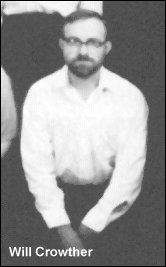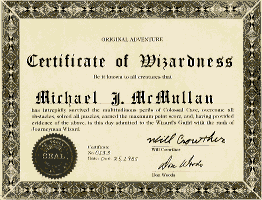
The origins of 'Adventure'
"I had been involved in a non-computer role-playing game called Dungeons and Dragons at the time, and also I had been actively exploring in caves — Mammoth Cave in Kentucky in particular.
"Suddenly, I got involved in a divorce, and that left me a bit pulled apart in various ways. In particular I was missing my kids.
"Also the caving had stopped, because that had become awkward, so I decided I would fool around and write a program that was a re-creation in fantasy of my caving, and also would be a game for the kids, and perhaps some aspects of the Dungeons and Dragons that I had been playing."
My idea was that it would be a computer game that would not be intimidating to non-computer people, and that was one of the reasons why I made it so that the player directs the game with natural language input, instead of more standardized commands. My kids thought it was a lot of fun."
— William Crowther
The Crowther and Woods 'Colossal Cave Adventure' game
Here's where it all began...
Before there was Doom, Ultima, Rogue, or even Zork, there was... Adventure.
There were other text computer games before Adventure, such as STARTREK and WUMPUS, but this was the first of its kind; the first text "interactive fiction" game. It may seem outdated and quaint by today's standards, sort of like seeing the Wright brothers' original flyer parked next to a Boeing 747, but many of us remember it fondly.
Will Crowther
In 1972, William Crowther and his wife Pat were working for Bolt, Beranek and Newman in Boston, otherwise known as BBN. Will was
| Crowther was known as a meticulous cave surveyor. He had a ASR33 Teletype set up in his living room, connected remotely to a computer at work, that he and several friends used to input cave survey data. His wife Pat wrote a program that would read this data and plot maps of the cave being surveyed. |
Still thinking of the many beautiful sights they had seen, including caverns with colorful names like "The Hall of the Mountain King" and "Twopit Room," Will Crowther produced plotter line-drawing maps of the cave from survey data of their explorations.
Other activities Crowther enjoyed were rock climbing and a regular game of Dungeons and Dragons, a roleplaying
| Crowther's name and writing appears often in RFC documents produced during the earliest days of the Internet, along with many other contributors from BBN. |
Unfortunately, Crowther's marriage ended in 1975. Sometime thereafter, feeling estranged from
his two daughters and wanting to be closer to them, he decided to write a program that
they might enjoy: a simulation of his cave explorations that also contained elements of his
fantasy roleplaying.
He was intrigued by the idea of trying a computer-mediated version of the game.

He wrote a computer simulation based on the maps, for a Digital Equipment Corporation PDP-10 computer, in FORTRAN. His first version included caver jargon such as "Y2" (a typical notation on cave maps denoting a survey point), and many of the names of rooms in this version came from actual features in the caves Will had been exploring.
Crowther's daughters enjoyed the game, and it was passed from friend to friend during the early days of the Internet, appearing on countless computers on and off the fledgling network. Often someone would install 'Adventure' in the wee hours of the night — without mentioning it to the computer staff — and move on, resulting in a mysterious yet impressive game program seeming to appear as if by magic.
Crowther's exploits have been chronicled in a number of books, both for his computer and caving activities:
- The Longest Cave, by Roger Brucker and Richard Watson
- When Wizards Stay Up Late, by Katie Hafner and Matthew Lyon
- Hackers: Heroes of the Computer Revolution, by Steven Levy
- The Soul of a New Machine, by Tracy Kidder
Don Woods
In 1976, Don Woods was working at Stanford University's Stanford Artificial Intelligence Lab, otherwise known by the acronym SAIL.
Woods found a copy of Crowther's
 rudimentary program left on one of the university computers by some unknown Johnny Appleseed, so to speak.
rudimentary program left on one of the university computers by some unknown Johnny Appleseed, so to speak.
He contacted Crowther by the simple expedient of sending email to "crowther@sitename," where sitename was
every computer then on the Internet, only a mere handful of sites at the time.
After corresponding with Crowther and getting his blessings, Woods greatly expanded the program.
The 'Adventure' continues
Jim Gillogly at the Rand Corporation spent several weeks in 1976 porting the code (with Woods' and Crowther's blessings) from the original FORTRAN source into C for UNIX. Most UNIX systems run successors of this C version. Gillogly later ported the code to Heathkit and then IBM-PC personal computers with the help of Walt Bilofsky, founder of The Software Toolworks (which was eventually renamed Mindscape). This version was marketed in 1981 under the name "The Original Adventure." Walt explains:
|
'Adventure' was distributed by DECUS, the Digital Equipment Corporation user group,
and was included on the first IBM PC machines.
Tracy Kidder, in his book The Soul of a New Machine, points out that Adventure was sometimes used as a strenuous test for new hardware being developed, as the game would exercise a broad range of programming functions. |
"I contacted Will Crowther, with whom I had worked at BBN in the early '70s, and arranged for him and Don Woods to endorse our product as the "official" version, in return for a small royalty. To further add value to our product, a user who earned all the points and found all the treasures would get a secret code from the program.
"On receipt of the code, we would send the player a lovely Certificate of Wizardness, bearing (facsimile) signatures of both Crowther and Woods, and an embossed seal. (It was pretty much the only use we ever got out of our corporate seal.) "

Various design questions during the game's conversion to UNIX were hashed out by "The UNIX Adventure Tastefulness Committee" — Crowther, Woods, Jim, Walt, Peter Langston, Dennis Mumaugh, and Lauren Weinstein.
The game spread like wildfire across the Internet, inspiring such obsessive efforts to solve the game that it is rumored numerous college seniors did not graduate that year as a result.